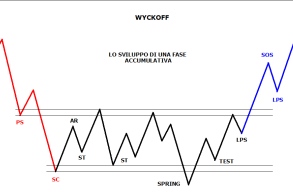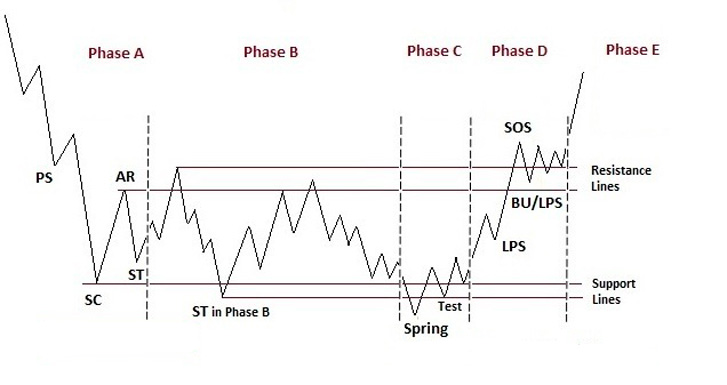Wyckoff diagram in the accumulation and distribution phase (part three)
This phase of the market is determined by price behavior near the support line, which is based on the price lows of a given time frame.

At this moment, the price slows down its downward movement, and then begins to move in the upward direction.
Events that occur during the accumulation phase
PS (preliminary support) shows the emergence of a significant number of buy trades after a long-term pullback, signaling that the downtrend may be coming to an end.
However, the volume of purchases is not yet enough to stop the price from falling further.
SC (Sales Climax - Selling Peak): This is the time when selling pressure reaches its peak.
Typically at this point the price will close above the SC, reflecting the underlying buying forces.

AR (Automatic Rally) : Selling pressure has eased significantly and new buying power has pushed the price higher. The highest price of this rally is the upper limit of the TR trading range in the accumulation phase. The lower limit is SC.
ST (Secondary Test): This is the time when the market re-tests whether the downtrend has truly ended. When a bottom is formed, that is, the price approaches the SC support area and moves up, the volume and spread decrease significantly. After the SC there may be one, two or more STs.
Spring (spring forward): This is usually a trap created by big forces to deceive investors into believing that the market will fall and sell shares, which will help these big players buy at a very low price before the market rises again.
In the accumulation phase, Spring is not required, i.e. may not happen due to strong resistance from the SC support area.
Test: Major forces often retest supply during TR or in key bullish positions. If supply increases significantly during testing, the market is not ready for an uptrend. Once the test is successful, price will form a higher low and volume will decrease.
LPS (last point of support): When the market begins to gain large volumes and price fluctuations, LPS forces the price to drop lower, as if gaining momentum in preparation for a strong attack and a breakout to a higher level. There can be more than one LPS point in the accumulation phase diagram.
SOS (Sign of Strength): As volume and price volatility increases, price will move beyond the TR range. Typically an SOS appears after a Spring, which is a way to confirm previous price action.
BU (Backup): A term coined by Robert Evans, a leading teacher of the Wyckoff method from the 1930s to the 1960s. According to him, BU can manifest itself in various forms, such as a rollback or a new TP at a higher level before the formation of an SOS.
5 small stages in the savings scheme
Phase A: marks a slowdown in the previous downtrend. Here supply still dominates demand. However, supply is weakening, as evidenced by the emergence of PS and SC.
Stage B: This is the stage of creating a “cause” in the law of cause and effect of the Wyckoff method. At this stage, major forces in the market begin to accumulate shares at low prices to catch the new uptrend. Accumulation can take a long time.
Stage C : In this stage, the crucial test (Spring) is carried out, which helps investors accurately determine whether the stock is ready to rise in price or not. In the Wyckoff method, when a successful Spring occurs, it gives investors the opportunity to trade with a high probability of success.
A low volume spring indicates that a stock is poised to rise in price, which is a good time for investors to place a buy order.
Phase D : Marks the time when price breaks through the resistance of the TR zone, starting a new uptrend. During this period, pullbacks, BU or LPS usually occur before the SOS is formed, which is a good time to enter more potential buy orders.
Stage E : This is the stage when the price has most clearly broken through the TR, demand is higher than supply. New, higher TRs may appear during this period, but usually with a shorter duration (same reaccumulation phase mentioned above).
TRs This new move is seen as a stepping stone for the price to move higher.
Wyckoff diagram at the distribution stage

TR during the distribution period is also divided into 5 periods, the events occurring in these 5 periods are generally opposite to the accumulation phase.
You can do the inverse analysis using a cumulative Wyckoff chart as above.
Continuation of the article part four “Composite Man” - https://time-forex.com/tehanaliz/kontseptsiya-sostavnoj-chelovek

